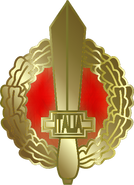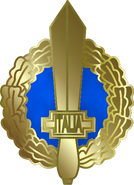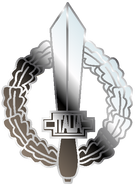| Milizia Volontaria per la Sicurezza Nazionale | |

| |
| The MVSN emblem | |
| Active | 1923 - Present |
| Country | Italian Social Republic |
| Branch | Party armed wing |
| Size | 721,160 |
| Part of | PNF |
| Headquarters | Palazzo della Milizia, Roma, Italy |
| March | Giovinezza |
| Colors | Black, Silver |
Template:Infobox military unit
The Milizia Volontaria per la Sicurezza Nazionale, or MVSN (Voluntary Militia for National Security) are the primary military reserve as well as PNF armed and security wing in Italy. The main role entrusted to the MVSN is to ensure national security and protection for the top Regime personnel against internal opposition and to serve as a counterbalance against coup attempts by the regular Army. MVSN is organised like infantry, and is to supplement the military and police serving as security in rear areas during wartime or in political emergencies, such as major protests against the government. From a formal point of view, the MVSN is a State organization under the control of the PNF Secretary: since mid 1990s, however, it has increasingly become a party police.
The Militia has delicate political tasks, but also military educational and strictly military duties. The MVSN also helps Police to maintain public order and to ensure the proper functioning of essential state services (in support to the Public Security), cares of the pre-military education, and oversees State borders with special border units.
Recruitment is strictly voluntary and most recruits are drawn from the Avanguardisti (GIL) who are at least 18 years old. The solemn function of the Fascist Muster is set for April, 21st of each year, and finished with the symbolic rite of delivery of the musket to recruits. Applications for entry of young people are collected by the Legion commands, which act as centres of mobilization. In case of a general mobilization of the armed forces of the State, the Legionnaires are absorbed by the Army, the Navy and the Air Force, with some exceptions. Despite provisions and official rethorics, this merger is considered as being a source of problems. In general, the Militia advocates a civil war heroism, and the indiscipline is an Arditi source of pride, while the Armed Forces enhance the patriotic values against the foreigners. The Militia merges into a single politico-military organization the energies of the war voluntarism, the pride of a Corps of aristocrats, the ideals of a national-patriotic political romanticism.
As a matter of collective identity, Blackshirts often have a picturesque and disturbing look, with their skulls embroidered on the chest, helmets painted red, and daggers tucked into wide leather belts. Their corporate appearance, although shunning extreme and military-like uniformity, is picaresque, bold and menacing- The political battle is carried out through with the hardest, the most relentless, the most scientific forms of violence. Militiamen are a kind of peasant warriors, with square jaws and broad boxeur hands. Blackshirts are not only violent, they are ruthless.
M.V.S.N. personnel, strictly only when in service, are Public Security Officers and Agents, according the actual rank, while members of Specialities are also Judicial Police Officers and Agents, according the rank. The M.V.S.N. (excluding the G.N.R.) consists of three main branches: 20,000 Legionnaires permanently serving into the Local Police Corps, with special regulations and paid by the relevant Province or Municipality; 15,000 permanent-service Legionnaires and of 450,000 partly rotating Legionnaires on 5-turns basis, assigned to the Provincial Legions; the remaining 201,000 partly rotating Legionnaires are assigned to Specialities, to the General Command and to some special units. The basic subdivisions are the Provincial Legions, which are grouped into 15 "Area Commands".
Police and public security training is conducted by the Public Security apparatus at a local level, including Specialities and special units; however, all MVSN Legionnaires have served their time in the military. Party indoctrination is at least as important as technical training. Once upon a time, MVSN pursued military activities after the revolution because the main threat facing Italy at the time was a military one. Now the MVSN has become involved anywhere if the country's security, or national interests are threatened. The MVSN is a sort of parallel institution, a an organ of repression not fully integrated within the State, although under the firm and though grip of the State authorities, that is involved in crushing protests, detaining activists, writers, and journalists in Party and State prisons, and threatening pro-democracy speakers and audiences at public events. The MVSN also has a crucial role in war and during national invasions: apart of people mobilized within the army, the Militia is tasked with fight behind front lines and alongside the regular army. During a national emergency, the Militia is (or has to be) the hub which collects all volunteers. Although formed into combat units, the Militia (as separate from the GNR) has not permanent line units, focusing on internal security and investigative duties. For the time being the main responsibility of the MVSN is to counter internal threats, and only aid the Army in case of external military threat; the aid to the Army comes from the GNR, which also provides the non-Italian armed corps, and from the Militia wartime organization.
Although the MVSN has to guard and defend the Fascist Revolution, in theory the MVSN as a whole has to avoid involvement in day-to-day politics by the Italian constitution, but its leadership is considered active. As a PNF-related organization, the MVSN does not adopt the typical military salute of the Italian military, but the Roman salute: right arm extended forward slant.
Legionary Oath[]
Before being admitted in the MVSN, each aspirant must take the Legionary Oath (Giuramento Legionario); the Oath is the same for all ranks.
| Oath in Italian: | Oath translated to English: |
|---|---|
|
Io, Legionario della Milizia, giuro davanti a Dio che servirò sempre con dedizione e fedeltà l'Impero, la Patria, la Rivoluzione e il Duce;
|
I, Legionnaire of the Militia, swear to God who always serve with dedication and loyalty of the Empire, the Homeland, the Revolution and the Duce;
|
Organization[]
The organization of the militia consists of a General Command, which is in control of "Militia Regions", composed of provincial Legions, which are the basic units: there are 110 metropolitan Legions and a War Veteran Legion, based in Rome and with a War Veteran Unit for each Legion, established in the provincial capital.
Each Legion consists of three Cohorts, in their turn formed by three Manipoli, which consist of two Centurie each. Each Centuria is made up of ten Squads.
The Legionaries, and especially the officers, they are divided into three categories:
- Permanent Service (mostly high officers, some sub-officers and troops and some specialized permanent units);
- Cadres (the vast majority of active personnel usually not in service, but they can be recalled in service);
- Reserve.
The majority of Legionnaires hold a civilian job full-time while serving part-time as a M.V.S.N. Cadre member. These part-time guardsmen are augmented by a full-time cadre of Permanent Service personnel, plus MVSN Technicians.
The system provides the chance for officers to pass upon demand from the Armed Forces in the Militia or vice versa. The General Command provides for the appointment of officers.
The services performed by the Legionaries up to the rank of Primo Caposquadra is not of a continuing nature (with the exception of some Permanent Service Legionnaires), but is based on the periodic visits, especially for rotation to the territorial garrisons and detachments, but also in view of particular events or reasons for training missions. The general mobilization is the responsibility only of the Duce. Enrolment is possible only if enrolled in the National Fascist Party.
Legionaries in permanent service are in turn divided as follows:
- Actual permanent service: providing non-stop service to the Commands and are paid on a monthly basis with fixed remuneration;
- Cadres who have a Command: despite being in service, they do not receive fixed compensation, except in cases of service outside of their residence.
Recruitment centres of the Militia are the Legion Commands, which examines applications and have a special Personnel Office. The appointment of MVSN Officers is carried out by the General Command on its own, differently from the Decree of the Duce required for Armed Forces officers. Alongside the division between Cadres and Permanent Service, MVSN units are classified according their operational range:
- General use units: mobile units designed to operate at national or at least inter-regional level; these are highly motorized, trained and armed units. All GNR units are considered to belong to the "General use" class, and some Provincial Legions in richest provinces may have one or two "General use" Maniples.
- Regional use units: units which carry a city defence or guard important sites within a relatively smaller (region or provinces group) territory. These are well motorized and armed units, but inferior to "General use" units. Most Provincial Legions and OVRA are capable to provide Regional use units. All Public Order Maniples must be at least Regional use units.
- Local use units: such units are assigned to local objectives and sites, and they perform territorial and provincial service only.
General Command[]
The General Command is the complex of the managing bodies of MVSN. The General Command provides disciplinary and administrative functions to the whole MVSN, as well as policies and requirements for training and funds for Territorial Legions. It is made up of the Commandant General, the Central Commission and the General Staff. Within the MVSN, the General Command is a legal entity on its own, which receives appropriations also for its own purposes, mainly ceremonial ones.
Commandant General[]
The Commandant General of the Militia is the commander in chief of the Militia and is appointed and revoked at any time by the Duce of Fascism, after consulting the Chief of Defence Staff. As part of the Militia, the Commandant General has higher hierarchical rank than all the MVSN officers. In case of absence, impediment or vacancy of office, he is replaced by the designated general officer.
Central Commission[]
The Central Commission of the MVSN is the body tasked with assisting the Commandant General of the MVSN. It consists of the four highest ranking officers: the Chief of Staff of the MVSN, the Secretary General of the OVRA, the Commandant General of the National Republican Guard and the Director General of the Central Security Office. Being the terminal of the three Party-controlled security organizations, the Central Commission is considered to be the counterpart of the Defence General Staff; however, it is a much weaker organization, due to the direct dependence of its constituent branches also on the Party and State leaders, but still useful in order to provide common logistical and operational support to all MVSN branches.
General Staff[]
The Militia General Staff is a military staff tasked with managing the MVSN (and some aspects related to the GNR and the OVRA):
- Organization Department;
- Information Office
- Situation Section
- Public Order Office;
- Training Department;
- Personnel and discipline Department;
- Health Department;
- Administration Department;
- Training Office;
- Political Office;
- Legal Affairs Office;
- Army Liaison Office;
- Public Security Liaison Office;
- Press Office
Militia Press Office[]
The MVSN has a Press and Propaganda Central Office at the General HQs. It is subdivided into five sections:
- Internal and Foreign Press Section (It: Sezione stampa interna ed estera);
- Propaganda Section (Sezione propaganda);
- Historical Section (Sezione storica);
- Radio-TV Broadcasting Section (Sezione Audiovisivo);
- Internet Communications Section (Sezione Comunicazioni Internet), which operates the official websites.
The Press Office is responsible for the regular publication of the fortnightly "Foglio d'Ordini", which works as official newspaper about the activities of the militia and the regular weekly "Milizia Fascista". The Legion Libraries are under the direct control of the Office. The Press Office also coorinates its counterparts in the Autonomous Republics.
Special Services Unit[]
The Special Services Unit (Italian: Reparto Servizi Speciali, R.S.S.) is an organization of the Militia, created to suppress dissent against the regime. The goal of the Unit is to work as a military police with the task of discovering and aiding to counter any military plans of the enemy. The Unit is known in intelligence circles for its hardness and ruthlessness against opponents and employs a staff of about sixty elements, divided into three teams: the "Scorpion", which was responsible for the murders; the "Falcon", in charge of counter-espionage, and "Team of Four Saints", in charge of the analysis and operational management. The Special Services Unit is directly suborinated to the Chief of Staff of the MVSN, in order to ensure the strictest political compliance.
The activity of the Unit focuses not only against the anti-fascists, but also against corrupt political leaders who are deemed to be dangerous for the military security. Intelligence operations of the Unit mainly consist of actions of gathering information and infiltration among the dissidents.
Information Office: MVSN Bulletins[]
The Information Office is the branch of the General Command tasked with the centralized direction of the Political Offices of Investigation. It has close ties with the O.V.R.A., although the Office is aimed to a surveillance duty. It also prepares the M.V.S.N. The bulletins of the Information Office of the General Command are typewritten police reports, which are prepared daily and sent in confidence to the Duce, the Commandant General and a few other fascist leaders. The news sent by provincial legions (Political Offices of Investigation) are collected from the General Command, which provides for the drafting of the bulletins, sorting breaking news and information by geographic area and by topic:
- "Abstention from work or strikes,"
- "Subversive and anti-national activities,"
- "Military News"
- "News received in the last hour"
- "Operations against bandits and rebels"
- "Public Order and public spirit"
- "Confidential notes and reminders"
- "Attachments"
- "Miscellaneous".
Militia Officers School[]
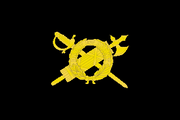
The flag of the MVSN Officers School
The loftiness and complexity of the tasks entrusted to a Permanent Officer of the Militia (in all its subdivisions, including the National Republican Guard and even the OVRA) needs the entailment of a qualified professional training, supported by a broad general education, while extolling the fascist values: the activity of the MVSN Officers School (Italian: Scuola Ufficiali della MVSN), reporting directly to the General Command of the Militia, has evolved constantly. The fundamental objective of the Officers School is the training of future Commanders through the Application courses (lasting three years after the two years of the Military Academy), which is associated with the professional development along the career. The School fulfils also the functions of a think tank, proposing research and development of professional and political issues.
Organization[]
The Officers School of the Militia is commanded by a MVSN Lieutenant General (who is also in charge of all training activities), and is structured on:
- Officers School Staff, which assists and advises the Commander in the operation of ordinary activities and planning of complex issues;
- Institute of Professional and Political-Military Studies, established in September 2000 with the aim to ensure better coordination of civilian and military education of teachers (next to the existing courses of Professional Techniques, Staff Service and Security Techniques, the following courses were established: Informatics, Military Law, Military Security, Territorial Control, Art of Military Operations, Security Keeping, Administration, Logistics and Military Medicine);
- Students Cohort, which takes care of the framing of students, contributing to their moral, political, ethical and military education.
Educational content[]
The educational commitment is further increased with the establishment of new roles and with the changes of curricula for officers: from the Academic Year 1994/1995, in fact, Officers coming from the Military Academy in Modena integrate the five-year training with graduation course in Science of internal and external security at the University of Rome Tor Vergata; in the same University, Officers can graduate in Law. By the school is provided a quarterly magazine in political-professional, the Review of the Militia (It: Rassegna della Milizia), established to update the preparation of the Legionaries, offering their insights concerning the development of fascist thinking and professional disciplines of interest and reviews of various books.
The school has always had intense international relations and exchanges with foreign institutes and academies party.
Ideological-Political Training[]
Since its inception, the Fascist regime has used Ideological-Political Training (Addestramento Ideologico-Politico, AIP) in order to forge the MVSN as a strong security force, tasked with confronting internal unrest and social revolt As time went on, the ideological component of the training has become almost more important than the military one: nowadays ideological-political training is incorporated into all levels of MVSN training, from basic training to refresher courses. Furthermore, Legionnaires have to take the AIP programs every year during their membership. Therefore the Ideological-Political Training is responsible for both basic and permanent ideological issues and for current political questions. Accordingly, daily bulletins are issued on key social, political, and economic issues, guiding political educators with respect to how to provide convincing answers to Legionnaires, especially in potential crisis periods occasioned by elections, political unrest, and other similar events.
The Office of the Training Director is in charge of the ideological-political training: it designs the programs, prepares the syllabi, writes textbooks, and trains educators. Political trainers in the MVSN are divided into three groups: organizational trainers, non-organizational trainers, and external trainers. They are responsible for strengthening the Fascist ethics and for justifying the national, regional, and international policies of the regime and for removing doubts with respect to these policies among Legionnaires.
Organizational trainers are employed as full-time Permanent Service MVSN Legionnaires, and their job is solely to teach the ideological-political course. A majority of this group have high school diplomas or less, and have passed short courses of ideological training at the Officers School. Non-organizational political trainers are members of the MVSN who are not official educators, but on account of their rank teach some political courses. Most are officers and commanders who are selected to discuss political issues with elite Legionnaires such as students, professors, engineers, and doctors. Finally, external trainers are usually P.N.F. leaders (mostly connected to Italo Debalti's faction) or prestigious Fascist scholars, such as elements of the School of Fascist Mysticism.
Specialities[]

All uniformed MVSN components and subcomponents, including even the National Republican Guard, wear the same standard uniform elements: black or khaki trousers and black shirt. Additional equipment varies according to the task assigned. The Legionnaire shown above is in its summer uniform.
MVSN Specialities provide police and public security specialized services within the broad scope of the whole MVSN:
- Border Militia (Milizia Confinaria) - alongside Public Security
- Medical Militia (Milizia ruolo medico)
- Militia Military Chaplains (Assistenza spirituale della Milizia)
- Railway Militia (Milizia Ferroviaria - Ministry of Public Transportations) - alongside Public Security.
- Labour Militia (Milizia del Lavoro - Ministry of Corporations)
- Forest Militia (Milizia Forestale - Ministry of Agricolture and Forestry) - alongside the Stare Forestry Corps
- Port and Air Militia (Milizia Portuaria and Milizia dell'Aria)- Coast Guard duties alongside Navy and airport police
- Highway Militia (Milizia della Strada - Ministry of Public Transportations) - alongside Public Security.
Each Speciality has an its own Inspectorate, Speciality Staff and Speciality Training School (the latter also crewed with police, for matters related to the police activities), which coordinate the relevant Speciality activities across national territory; specialities of the Militia also recognize a technical and professional dependence on the competent Ministry and the competent Public Security authority.
Railway Militia[]
The Railway Militia (Milizia Ferroviaria, Mil.Fe.) is a MVSN Speciality governed by the Ministry of Transportations and the tasks of entrusted to militia are all related to the railways security and safety. Main tasks are prevention and repression of misuse in transportation of people and goods, personnel surveillance, railway patrols, guard service to freight and in mobile material depots, escort to trains and political police on the rail. In addition, they often conduct joint police activities with the Railway Police Service.
The personnel of the Railway Militia is drawn from the officials and agents of the administration of the State Railways, preferably members of the Fascist Railwaymen Association. The elements that provide permanent service are then by the State railways to the Militia for the duration of this service. The Railway Militia is organized on 23 Legion Detachments, 100 Railway Station Commands, a Speciality School and the Speciality Inspectorate.
Labour Militia[]
The Labour Militia (Miliizia del Lavoro, Mil. La.) is the MVSN Speciality which has the task of effectively combating the phenomena of social unrest related to work. The Labour Militia frames the Labour Militia Inspectorates Squads. The Labour Militia operates at functional dependencies of the Ministry of Corporations, is head-quartered in Rome at the Ministry, and is a structure which belongs to the Voluntary Militia for National Security for what concerns the training, sorting, discipline and career progress. From a personnel-related point of view, the Mil.La. consists of personnel with a high level of professionalism and operational efficiency and is set up to be able to exercise vigilance in the application of laws relating to labour and social security systems wherever there is a wage or salary or a salary. Differently from all other Specialities, the Mil.La. is completely autonomous from Public Security or other State corps.
Personnel is selected in relation to tilt and preparation of inspection efforts, experience and or aptitude for investigative activities and technical and professional preparation in the particular field, achieved by attending special courses.
The tasks are mainly directed at ascertaining violations of labour law. The personnel of the Labour Militia, in the exercise of their functions, are given "powers of inspection and supervision" necessary to carry out all the tasks of monitoring and verification.
The Labour Militia, at the central level, consists of:
- Speciality Inspectorate
- Speciality School
- Analysis Section with a monitoring tasks of inspection activities at the national level, as well as observation of the phenomena related to the world of work.
While, at the peripheral level, it consists of:
- 5 Groups with inter-provincial responsibility, with offices in the cities of Milan, Padua, Rome, Naples and Palermo, which report to the Inspectorate and are directed by officers having the rank of Prime Tribune.
- 110 Legion Detachments Labour Inspectorates, established at the Provincial Corporatist Labour Inspectorates. Each Detachment is administratively dependent on the Legion of the province where it is deployed.
Within each Group there is an Investigative Squad that operates within the territorial jurisdiction and increases the contrast of the greatest social phenomena, the connotation and the resulting inter-activity of the Judicial Police. The provincial detachments receive from their respective inspectorates general guidelines regarding the particular service they are asked to perform.
Legion[]
The MVSN Legion is the basic organizational element. It has a provincial-related jurisdiction, and each Legion manages all MVSN activities within its Province, ranging from territorial presence to public order, public security and civil protection support activity.
The MVSN of the several Provinces and Autonomous Republics serves as part of the first-line of defence. The provincial Militia is organized and operates under their respective Prefect or Chief of Republic (and under territorial governors of the Autonomous Republics), as well as under their local Party leaders. Prefects (in Italy) exercise control through the Quaestors and the P.N.F. Provincial Federal Secretary. Outside the Party hierarchy, the MVSN may be called up for active duty by a variety of bodies and figures: Prefects, local military authorities and the Minister of Interior to help respond to domestic emergencies and disasters, such as riots and civil disorder, unrest, revolts, hurricanes, floods, and earthquakes.
During wartime, permanent personnel of each Legion form infantry units attached to the Army; MVSN officers act as Army officers within the MVSN units. However, during wartime the vast majority of Cadres personnel is mobilized as ordinary part of the Armed Forces. During military actions other than major wars, whole Legions can be recalled as MVSN formations and transformed into combat units; in this case, each Legion forms an Infantry Battalion-level unit. Moreover, Legions are in charge also of Local Police Corps, which are recruited among M.V.S.N, personnel; however, Local Police are not part of the Provincial Legions.
Each Legion has an average strength of 900 men each Legion; however, the Legion of Rome has three times the average Legionnaires numbers, while Legions of Milan, Naples, Palermo and Cagliari are twice the average Legion size.
During peacetime, Legions' primary task is the territorial presence, organized trough a garrisons and detachments network, in order to watch over political stability and over police forces.
The whole complex of the Provincial Legions, at any point of the year, deploys in active service 105,000 Legionnaires: from this number, however, are excluded all Specialities. The presence of 105,000 Legionnaires at any point of year means that the Provincial Legions (sometimes dubbed as "Territorial Militia") have a total rotation of 450,000 Legionnaires.
Each Provincial Legion is commanded by a Seniore (equivalent to a Colonel), who directs all offices subordinated to the Legion Command, in turn held by a Prime Tribune (It: Primo Tribuno, corresponding to a Lieutenant Colonel), who also acts as Commander's deputy. Offices and Services are each commanded by a Tribune (It: Tribuno, equivalent to Major) or a Maniple Chief (It: Capomanipolo, Captain). All commanders and staff teams are of permanent service, while troops and platoon leaders are Cadres.
- Legion Command Maniple (permanent service)
- Chaplain detachment
- Personnel Office
- Political Office of Investigation
- Recruitment Centuria/Cohort
- Speciality Detachments (with the exception of Medical Militia; mixed): not counted within the numerical limits of the Provincial Legion;
- Detachment Commands (permanent service)
- Detachment troops (Cadres)
- Public Order Maniple (permanent service + Cadres)
- Civil Protection Maniple (Cadres)
- Medical Detachment (Cadres)
- Territorial Garrisons (Cohort-level) and Detachments (Maniple-level)
- Garrisons and Detachments Commands (permanent service)
- Garrisons and Detachments troops (Cadres)
Territorial Detachments are frequently head-quartered near to large State factories, in order to "defend the property of the Italian people", while Garrisons are based next to large provincial centres, and usually carry out general and political police surveillance duties. The Detachment Commander (a Maniple Chief) has a Political Deputy (It: Delegato Politico, belonging to the PNF) and a Deputy Commander, plus a supply officer and a chief medical orderly. Other personnel include the four platoon leaders, four deputy platoon leaders, 184 Legionnaires and four medical orderlies (one per platoon).
Political Office of Investigation[]
The Political Office of Investigation (Ufficio Politico Investigativo, U.P.I.) is, in any Legion, the office of the political police of the MVSN. Political Offices of Investigation at the provincial legions are among the principal OVRA territorial instruments of repression. These offices are partially overlapping with the public security apparatuses, which have to cooperate with. Each UPI depends on the relevant Legion Command and is usually subdivided in three sections: central section, interrogations section, investigative section.
Theoretically, all information politically relevant are to be transmitted to the Political Office of the Questura and to the Second Central Directorate of the OVRA. In practice, the UPI acts more as provincial branch of the OVRA, and few information are transmitted to the Public Security. Moreover, UPI are often used by local Party Federal Secretaries in order to keep an eye over their internal adversaries, as well as their own power instrument.
The members of the Political Offices of Investigation are also charged with using their local knowledge to track down and arrest deserters from the military and to track down rumours and those who instigated or spread them.
Public Order Maniple[]
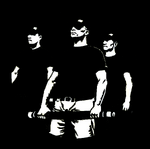
MVSN security service at a PNF rally. Often the Public Order Maniples wear casual robes (with black caps and t-shirts) and carry bars.
The Public Order Maniple is the mixed unit responsible for carrying out public security duties assigned to the MVSN; its command and training echelon is always in permanent service, while ranks-and-files rotate according their own shifts. Although it is classed as a Maniple, the denomination is referred to its full size: in ordinary, less than a Centuria is always in service, with the other people being under a pre-alert. Maniples are centrally directed by the Public Order Office. The Public Order Maniple is the direct heir of the Action Squads, and often keep their labarum or standard. In early 1990s, such Maniples played a prominent role in street fighting during the wave of Debalti-led protests earlier this year, often swearing fealty and pledging loyalty to Debalti himself and thus being the spearhead of "new fascists" against the crumbling government of that time.
The Maniple assists and reinforces Celere units when requested to do so, but its primary task is to form the backbone of the security services at major official PNF meetings and rallies; in case of national meetings or rallies, each Maniple has to send a detachment to the meeting, in order to form a reliable force to provide crowd control security services. However, the general mobilization for public order/emergency reasons can be ordered only by Duce Italo Debalti.
Wartime organization[]
During wartime and in case of danger of a national invasion, the provincial organization radically changes its organization and assets in order to replace military personnel under arms. MVSN units during wartime are placed under direct command of the local PNF. Though normally under party control, the "War Militia" units are placed under Army command when engaging in action. The basic unit is a War Cohort of 642 men. Units are mostly composed of members of the GIL, invalids, the elderly, or men who had previously been considered unfit for military service:
- A War Cohort (Battalion) in every Province;
- A War Maniple (Company) in every Administrative District (It: Circondario Amministrativo)
- A Platoon in every Subdistrict (It: Mandamento)
Each Federal Secretary, has a MVSN Chief of Staff to assist in handling militia problems.
Uniforms and insignia[]
The M.V.S.N. and its subcomponents have a complete set of rank insignia, military badges and military uniforms, in order to display the unity of action of every member and body; this improves the esprit de corps, and contributes to the identity formations of both the collective body (as opposed to the Army and in general to the State Armed Forces) and the individual member, becasuse an uniform is the best media by which deliver the message of belonging to a particular Corps or political militia.
Gladius and Laurel Wreath[]
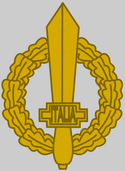
Distinctive insignia of the Party armed units. The gladius bears the wording "ITALIA".
The distinctive badge common to all Party armed units is made up of the Roman Gladius and the laurel wreath, in opposition to the military five-points stars. The gladius and laurel wreath with black berries have Roman roots and are a symbol, the former, strength and value and, the latter, of honour and victory. The gladius is also a tradition of willingness and ability to achieve dual objectives, both inside and outside. Gladius and Laurel are the Idea and the Nation and also indicate two destinations: the unity of the Fatherland and the glory of arms.
However, the gladius-and-wreath policy is strictly enforced only within OVRA and GNR; being a voluntary and political militia, the bulk of the MVSN openly tolerates and in some cases even continues to issue Fasces to pin on collars. Even very senior officers could wear fasces instead of Gladius-and-Laurel Wreath, on the basis that the fasces is always an honoured and very respected Fascist symbol. This is most common in Provincial Legions, but also some Legionnaires of permanent units wear the Fasces.
As if that was not enough, GNR combat formations wear a stylized "M" and elite security units a red "M" with fasces.
Ranks and insignia of the M.V.S.N.[]
The MVSN and its subcomponents (GNR and OVRA) are military-organized bodies and have complete ranks and uniforms. While the MVSN has retained (although with some changes) the orginal rank structure of its founding years, both GNR and OVRA have military-like rank names; however, shoulder boards are identical for all the three branches.

Shoulder board for MVSN symphonic band and GNR and OVRA brass bands (all ranks).
| MVSN Subofficers ranks and insignia | |||
|---|---|---|---|
| MVSN rank | Aiutante | Aiutante Capo | Primo Aiutante |
| English translation | Adjutant | Chief Adjutant | Prime Adjutant |
| Corresponding Army rank (Italian) | Maresciallo | Maresciallo Capo | Maresciallo Maggiore |
| Corresponding Army rank (British Army) |
Warrant Officer Class Two | Warrant Officer Second Class | Warrant Officer First Class |
| Shoulder board insignia |  |
 |

|
Ordinary and Full Uniform[]
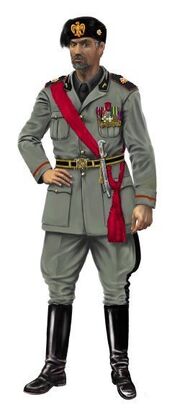
M.V.S.N. senior officer in Full Uniform.
The Ordinary Uniform (It: Uniforme Ordinaria, often shortened in "Ordinaria") is worn both in service only for part-time units and both in service and out of service for permanent personnel. The jacket is in twill and has the form prescribed for the Army, with black buttons which have the "RSI" cyphers. The neck is opened and black cloth-trimmed, adorned with the relevant insignia. The hand guards are red. The four pockets are of patch-type, with central torch and flaps. The shoulder boards bear the rank insignia.
The shirt is black and his tie is in black rayon. The trousers are riding short pants, with double black stripes; also long trousers without bands are provided. The cap is in grey-green twill fabric and bears the frieze of the Militia; alternatively is worn the fez of the Militia. Finishing touches: blacks boots with spurs or shoes depending on the type of used trousers and black leather gloves.
In winter the Legionnaire wears the coat of black fabric, with the same cut prescribed for Army officers, that is up to 20 cm long below the knee, double-breasted and closed by a double row of three large buttons silver; the two slit pockets are closed by the same number of fins and, for officers, below the left side there is an opening to allow the passage of the pendants of the flakes of the garnet red officer scarf which is always worn over the jacket.
The Full Uniform is based on the Ordinary Uniform, with the adding of some items, namely the officer scarf, the black belt (with golden trims for officers) and the Squadrist dagger.
Service Uniform[]
The Service Uniform (It: Uniforme di Servizio) consists of a pattern simpler than the Ordinary Uniform; this is the most common uniform and it is widely used. All personnel wear black cargo trousers, black shirt and black infantry combat boots. The shirt may be long or short sleeved according the season, and has two patch-style breast pockets; the winter shirt is in heavy wool specifically treated. Under ordinary circumstances the cap which is used is the beret, but if required by the situation also the helmet can be worn.
Units deployed in mountain areas with particularly cold climates use a black sweater instead of the black shirt, and wind-breaker jacket with heavy internal lining. The sweater can replace the shirt even in public order, patrolling, manhunts and round-ups services.
Equipment[]
The MVSN on its own (separated from both GNR and OVRA) has both civilian and military equipment for the fulfilment of its duties. The primary features of the MVSN equipment, direct inheritance of the 1920s Action Squads, are the baton: all MVSN personnel, regardless of the rank, use a straightstick 74 cm-long baton and a dagger. The baton nowadays is a long cylinder with a wrapped grip, with a slightly thicker shaft and rounded tip. They are made of aluminium covered by rubber.
Riot equipment[]
MVSN riot equipment is not as advanced as equipment issued by the Celere units, although the personnel is fully protected. The riot gear consists of several elements although they should remain a garment light, simple and easy to wear and at the same time protect the Legionnaire from attacks, kicks, punches and blows. The uniform is made of flame-resistant material Nomex. The uniform is a black operational suit with a crescent that incorporates the colours of the Italian flag on the right sleeve and the badge of the Legion. The suit is topped by a "combat vest" which consists of a vest with pockets and a belt that hosts the holster (thigh) of the gun. The personal protective equipment is completed by items like flak jackets, gas masks and riot helmets. The communication is guaranteed by radio transmitting equipment smaller and lighter with headphones so as not to interfere with the agility of the agent.
- Riot helmet: Benelli CAS "Legionario M2000", with back-of-the-neck protector, transparent polycarbonate visor, built-in radio microphone and earpieces.
- Riot shield: Benelli "Scudo M95", polycarbonate, rectangular with rounded corners, curved in the horizontal cross-section to shed thrown objects, and slightly curved in the vertical cross-section at the top and bottom. The size is 75x100 cm.
- Gas mask: Melloni MAG M2000
- Grenade launcher: Beretta LG40
Light weapons[]
Light weapons used by the MVSN include personal and unit military weapons. Ordinarily only the personal weapons are carried on external service.
- Personal weapons:
- Beretta 92 FS cal. 9 mm (semi-automatic pistol)
- Beretta Model 12 (submachine gun)
- Beretta AR70/90 (assault rifle)
- Unit weapons:
- MG 42/59 (machine gun)
- Morelli FP 90 S (sniper rifle)
- Franchi SPAS-15 (combat shotgun)
Mortars[]
The mortars are an important resource in the combat infantry. Simple to use, they can open fire from covered positions a lot and thanks to the target trajectory are strongly arched able to beat a low profile targets to artillery fire. The MVSN only has light mortars (60 mm); currently the Militia uses the German Hirtenberger 60 mm.
Anti-tank weapons[]
Depending on the range anti-tank weapons are used by specialized units in the fight against tanks or are distributed as a self-defence equipment of all combat units. The MVSN has mainly rocket-launchers:
- Anti-tank rocket launcher "Folgore"
- Anti-tank rocket launcher "Panzerfaust 4"
- Anti-tank short-range guided missile Oto Melara "MILAN"
- Anti-tank and anti-personnel fire-and-forget guided missile Oto Melara "Aspide"
Tactical vehicles[]
- Enduro 350cm3
- Land Rover VAV AR 90 (attack jeep)
- Iveco VTLM Lince (light multirole vehicle)
- Fiat VM 90 Torpedo (light multirole vehicle)
- Iveco VM 90 (light multirole vehicle)
- Iveco ACTL 4x4 (light truck)
- Iveco ACTL 6x6 (medium truck)
- Land Rover Discovery (protected): for security purposes
- Fiat Ducato 4x4 (armoured): for security purposes
- Iveco Eurocargo 6x6 P (armoured): for security purposes
- Rayton Fissore Magnum (protected): for security purposes

